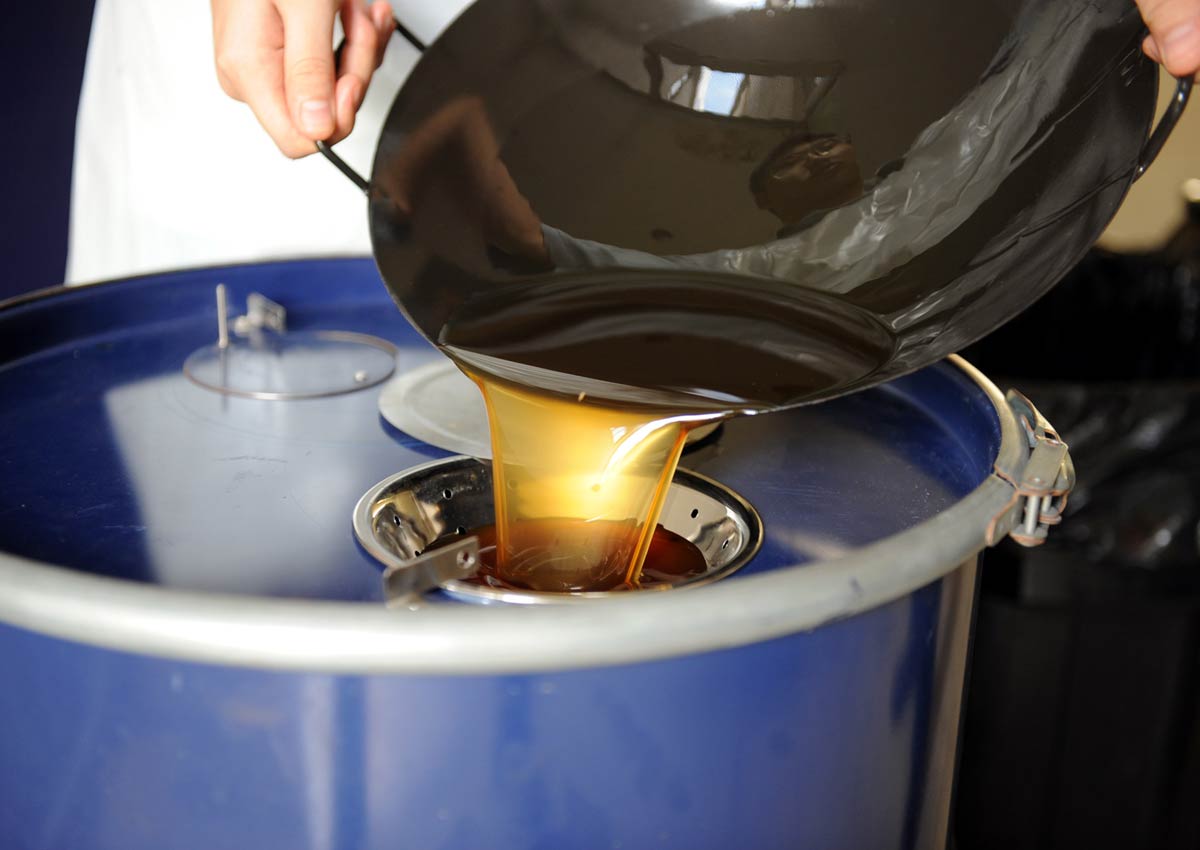

Articles
How To Store Linseed Oil
Modified: December 7, 2023
Learn the best practices for storing linseed oil in this comprehensive guide. Discover how to keep your linseed oil fresh and extend its shelf life. Get expert tips and advice on proper storage methods to ensure the quality of your linseed oil.
(Many of the links in this article redirect to a specific reviewed product. Your purchase of these products through affiliate links helps to generate commission for Storables.com, at no extra cost. Learn more)
Introduction
Welcome to our comprehensive guide on how to store linseed oil. Linseed oil is a widely used natural oil extracted from flaxseeds. It has numerous applications, from being mixed with paints and varnishes to used as a wood finish or a dietary supplement rich in omega-3 fatty acids. Regardless of the purpose for which you’re using linseed oil, proper storage is essential to maintain its quality and extend its shelf life.
In this article, we will walk you through the best practices for storing linseed oil. We’ll cover the importance of using proper storage containers, considerations for temperature and humidity, avoiding exposure to light, the best storage locations, and tips for extending its shelf life. By following these guidelines, you can ensure that your linseed oil remains in optimal condition for all your projects or dietary needs.
Key Takeaways:
- Proper storage of linseed oil is crucial for maintaining its quality and extending its shelf life. Choose the right container, control temperature and humidity, and avoid light exposure to preserve its integrity.
- To maximize the shelf life of linseed oil, keep containers clean, tightly sealed, and labeled. Store in suitable locations and follow best practices to ensure optimal quality for artistic, woodworking, or dietary use.
Read more: How To Store Oil
Understanding Linseed Oil
Before we delve into the details of proper linseed oil storage, let’s first understand what exactly it is. Linseed oil, also known as flaxseed oil, is derived from the seeds of the flax plant (Linum usitatissimum). It has been used for centuries for its various properties, including as a drying oil and as a supplement for its nutritional benefits.
Linseed oil is commonly used in the arts and crafts industry as a binder in paints, varnishes, and wood finishes. It dries slowly and creates a durable and glossy finish. It is also popular for its versatility in the culinary world and is often used as a dietary supplement due to its high levels of omega-3 fatty acids.
It is important to note that there are two main types of linseed oil: raw linseed oil and boiled linseed oil. Raw linseed oil is unprocessed and takes a longer time to dry, making it suitable for certain applications, such as oil painting. Boiled linseed oil, on the other hand, has been treated with drying agents, which reduces its drying time. Boiled linseed oil is commonly used as a protective coating for wood.
Now that we have a basic understanding of linseed oil, let’s move on to the best practices for storing it to maintain its quality and shelf life.
Proper Storage Containers
Choosing the right storage container is crucial for preserving the quality of linseed oil. It is recommended to store linseed oil in airtight containers that are specifically designed for storing oils or other liquids. The container should be made of a material that is resistant to corrosion or chemical reactions, such as glass or dark-colored plastics.
Glass containers are an excellent choice as they are non-reactive and do not leach any harmful substances into the linseed oil. Additionally, glass containers provide an extra layer of protection against light exposure, which we will discuss in more detail later.
If you prefer using plastic containers, make sure they are made from high-density polyethylene (HDPE) or polypropylene (PP) which are more resistant to oils and chemicals. It is important to choose containers that have a tight-fitting lid or cap to prevent air from entering and oxidizing the linseed oil.
Avoid storing linseed oil in metal containers, as they can react with the oil and affect its quality. Metal containers may also corrode over time, potentially contaminating the linseed oil. However, if you need to use metal containers, ensure they are lined with a food-grade epoxy resin coating to prevent any interaction between the metal and the oil.
Remember to clean the storage container thoroughly before filling it with linseed oil. Any residue or contaminants left in the container can compromise the quality of the oil. Ensure the container is completely dry before adding the linseed oil to prevent any moisture from affecting the oil’s composition.
By selecting the appropriate storage container, you can protect your linseed oil from external factors and maintain its integrity for an extended period.
Temperature and Humidity Considerations
Proper temperature and humidity levels are crucial for preserving the quality of linseed oil. Fluctuations in temperature and exposure to excessive humidity can degrade the oil and reduce its shelf life.
It is recommended to store linseed oil in a cool and dry environment, away from direct sunlight and sources of heat. Fluctuating temperatures can cause the oil to oxidize and spoil more quickly. Ideally, the storage area should have a consistent temperature between 50 to 70 degrees Fahrenheit (10 to 21 degrees Celsius).
Excessive heat can cause linseed oil to deteriorate and become rancid. Exposure to high temperatures can also lead to the formation of harmful compounds that can affect the quality and safety of the oil. Therefore, it is crucial to avoid storing linseed oil in places like attics, basements, or areas that are prone to significant temperature fluctuations.
In addition to temperature, humidity levels should also be considered. High humidity levels can cause linseed oil to oxidize faster, leading to a shorter shelf life. Moisture can also promote the growth of bacteria and mold, compromising the quality of the oil.
It is best to store linseed oil in a location with low humidity levels, ideally below 50%. If you live in a humid climate, consider using a dehumidifier in the storage area to control humidity levels. Additionally, ensure that the storage container is tightly sealed to prevent moisture from entering and contaminating the oil.
By storing linseed oil in a cool and dry environment with controlled temperature and humidity levels, you can maximize its shelf life and maintain its quality for a longer period.
Store linseed oil in a cool, dark place to prevent it from going rancid. Keep it tightly sealed to minimize exposure to air, which can cause oxidation. Avoid storing it near heat sources or direct sunlight.
Avoiding Exposure to Light
Exposure to light can have a detrimental effect on the quality and stability of linseed oil. Light, particularly ultraviolet (UV) light, can accelerate the oxidation process and cause linseed oil to degrade more quickly. To protect your linseed oil, it is essential to store it in a dark or opaque container that blocks out light.
Glass containers, especially amber or dark-colored glass, are an excellent choice for storing linseed oil. The dark color of the glass helps to filter out harmful UV rays and minimize light exposure. This preserves the integrity of the oil and prevents oxidative breakdown.
If you are using plastic containers for storage, make sure they are opaque or made from a material that blocks out light. Look for plastics that are specifically designed to protect light-sensitive substances. Avoid using transparent or clear plastic containers, as they offer little to no protection against light damage.
In addition to choosing the right storage container, it’s crucial to find a dark and sheltered location for storing your linseed oil. Keep it away from windows, direct sunlight, and any other sources of light that could compromise the oil’s quality. A pantry, cupboard, or closed cabinet are all suitable options for storing linseed oil.
Remember to always secure the lid or cap of the storage container tightly after each use. This will prevent any light from entering the container and coming into contact with the linseed oil.
By avoiding exposure to light, you can significantly prolong the shelf life of linseed oil and ensure its quality remains intact whenever you need to use it.
Read more: How To Store Truffle Oil
Best Storage Locations
Choosing the right storage location for your linseed oil is essential to maintain its quality and maximize its shelf life. Here are some of the best storage locations to consider:
- Dark and Cool Pantry: A pantry is an ideal storage location for linseed oil. It is typically dark and provides a consistent temperature, away from direct sunlight and heat sources. Make sure the pantry is well-ventilated to prevent the accumulation of moisture and humidity.
- Closed Cabinet: If you have a closed cabinet in your workspace or storage area, it can be an excellent spot to store linseed oil. Ensure that the cabinet is away from windows and other light sources to prevent exposure to light. Maintain a moderate temperature and humidity level in the cabinet to preserve the oil’s quality.
- Refrigerator: If you live in a warm climate or want to extend the shelf life of linseed oil, you may consider storing it in the refrigerator. Linseed oil can be refrigerated, but it is important to keep it in an airtight container to prevent any moisture from affecting the oil. Before using refrigerated linseed oil, allow it to come to room temperature naturally to avoid condensation inside the container.
- Cool Basement: If you have a cool and dry basement, it can be a suitable storage location for linseed oil. Ensure that the area is well-ventilated and free from excessive moisture and temperature fluctuations.
Remember, regardless of the storage location you choose, it is crucial to keep linseed oil away from extreme temperatures, direct sunlight, and moisture. Consistency is key, so finding a spot with stable temperature and humidity levels is essential.
Lastly, it is essential to ensure that the linseed oil containers are stored upright to prevent leakage or any potential damage that may compromise the oil’s quality.
By selecting the best storage location for your linseed oil, you can safeguard its integrity and maintain its usability for a longer period.
Tips for Extending Shelf Life
To maximize the shelf life of your linseed oil, here are some tips and best practices to keep in mind:
- Ensure a clean storage environment: Before transferring linseed oil to its storage container, make sure the container is clean and free from any contaminants. Even the smallest residue can compromise the quality of the oil. Additionally, keep the storage area clean to prevent any dust or debris from entering the containers.
- Avoid cross-contamination: When using linseed oil, be cautious not to introduce any foreign substances into the container. This can include dust, paint particles, or any other materials that can affect the integrity of the oil. Similarly, do not return used linseed oil back into the original container to avoid contamination.
- Keep lids tightly sealed: After each use, ensure that the lids or caps of your linseed oil containers are tightly sealed. This helps to prevent air, moisture, and contaminants from entering the container and affecting the oil’s quality. It also helps to minimize the oxidation process.
- Store different grades separately: If you have different grades or types of linseed oil, it is recommended to store them separately. This is particularly important for raw and boiled linseed oil, as they have different drying times and chemical compositions. Storing them separately ensures that each type maintains its unique characteristics and quality.
- Label and date your containers: To keep track of the age and type of linseed oil in each container, label and date them accordingly. This helps you identify the oil easily and ensures that you are using the freshest oil for your projects or dietary needs.
- Use smaller containers: If you have a large quantity of linseed oil, consider transferring it to smaller containers. This reduces the amount of air inside the containers, minimizing oxidation and extending the shelf life.
- Rotate your stock: If you use linseed oil infrequently, consider rotating your stock. This means using the older containers of linseed oil first and replenishing your supply with fresh oil. By doing so, you ensure that you are using the oil within its optimal shelf life.
Following these tips will help you extend the shelf life of your linseed oil and maintain its quality over time. Remember, linseed oil does have a limited shelf life, so it’s essential to use it within the recommended time frame for the best results.
Conclusion
Proper storage of linseed oil is key to preserving its quality and ensuring its longevity. By following the guidelines outlined in this article, you can effectively store linseed oil and maintain its integrity for all your artistic, woodworking, or dietary needs.
Start by selecting the right storage container, such as glass or dark-colored plastic, that is airtight and resistant to corrosion. Avoid storing linseed oil in metal containers that can react with the oil and compromise its quality. Ensure the containers are clean and dry before transferring the oil to prevent any contaminants from affecting the oil.
Consider the temperature and humidity levels in the storage area and aim for a cool and dry environment to protect the oil from degradation. Avoid exposure to light, especially UV light, by using dark or opaque containers and storing them in dark locations. Remember to always keep the containers tightly sealed to minimize air exposure.
Optimal storage locations include dark and cool pantries, closed cabinets, or refrigerators (if necessary). These areas provide the right conditions to help preserve the linseed oil. Additionally, follow some additional tips, such as keeping the storage area clean, avoiding cross-contamination, and labeling and dating the containers for easy identification and rotation.
By implementing these best practices and tips for extending the shelf life of linseed oil, you can ensure that your oil remains in top-notch condition for your artistic projects, woodworking endeavors, or dietary supplementation. Remember to always check the specific instructions for the linseed oil you are using, as different brands or grades may have slight variations in storage requirements.
With proper storage, you can make the most out of your linseed oil and enjoy its benefits for an extended period. So, take the necessary steps to store your linseed oil correctly, and let it enhance your creative projects or contribute to your healthy lifestyle for years to come!
Frequently Asked Questions about How To Store Linseed Oil
Was this page helpful?
At Storables.com, we guarantee accurate and reliable information. Our content, validated by Expert Board Contributors, is crafted following stringent Editorial Policies. We're committed to providing you with well-researched, expert-backed insights for all your informational needs.















0 thoughts on “How To Store Linseed Oil”